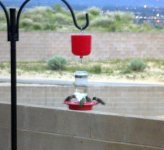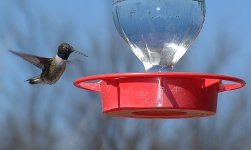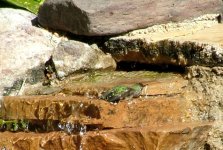-
Welcome to BirdForum, the internet's largest birding community with thousands of members from all over the world. The forums are dedicated to wild birds, birding, binoculars and equipment and all that goes with it.
Please register for an account to take part in the discussions in the forum, post your pictures in the gallery and more.
You are using an out of date browser. It may not display this or other websites correctly.
You should upgrade or use an alternative browser.
You should upgrade or use an alternative browser.
Rare Sight (1 Viewer)
- Thread starter desertdharma
- Start date
More options
Who Replied?cavan wood
Well-known member
Wholly happy hummers!
I was also wondering about the ant guard. How's it kept upright? Do you use water in it? How long does it last before it all evaporates?
Scott
I was also wondering about the ant guard. How's it kept upright? Do you use water in it? How long does it last before it all evaporates?
Scott
desertdharma
Member
I realized I forgot to mention that all four were male black-chinned hummers!
The feeder was one highly recommended by the lady who owns the Wild Bird store near us. It was under $15 as I recall. It's easy to fill and easy to keep clean. There are two sections to the red reservoir below the bottle; they separate easily for cleaning, and the bottle simply screws on. There are eight little holes for feeding. The ant guard hangs from the pole, and the feeder hangs from the ant guard (the ant guard was optional, but I thought it was a good idea). I keep the ant guard clean and filled with water (about 1/2" from the top). I haven't seen the hummers drinking from it, but who knows, they may be! I add a little more water every other day or so; it's dry here. We have a thistle feeder hanging from another section of the same pole that the house finches love, and I have seen one of them drinking from the ant guard. The thistle feeder is a long one with mesh all around rather than holes and perches, and the finches love it. We've seen 6-7 on the tube at one time.
Yesterday I went out to straighten the hummingbird feeder (to make sure the sugar water was filling the bottom part adequately) and had a close encounter! A male black-chin came swooping down at me to within a foot of my face and brought himself up hovering right in front of my nose. That was SO fun -- just to hear him close-up like that and feel the air moving from his wings. I couldn't help but laugh and say "well excuse me!" Guess now I know whose feeder it is!
Also while out walking last week about a block from our house (starting out on one of our favorite trails), my husband and I saw a male black-chin doing a very impressive 3-foot pendulum-swing flight next to a desert bush -- we assume a female was watching his performance from somewhere inside! That was just incredible -- he kept it up for a few minutes. He made a buzzing sound the whole time, and seemed oblivious to our presence, even though we were only about six feet away.
The feeder was one highly recommended by the lady who owns the Wild Bird store near us. It was under $15 as I recall. It's easy to fill and easy to keep clean. There are two sections to the red reservoir below the bottle; they separate easily for cleaning, and the bottle simply screws on. There are eight little holes for feeding. The ant guard hangs from the pole, and the feeder hangs from the ant guard (the ant guard was optional, but I thought it was a good idea). I keep the ant guard clean and filled with water (about 1/2" from the top). I haven't seen the hummers drinking from it, but who knows, they may be! I add a little more water every other day or so; it's dry here. We have a thistle feeder hanging from another section of the same pole that the house finches love, and I have seen one of them drinking from the ant guard. The thistle feeder is a long one with mesh all around rather than holes and perches, and the finches love it. We've seen 6-7 on the tube at one time.
Yesterday I went out to straighten the hummingbird feeder (to make sure the sugar water was filling the bottom part adequately) and had a close encounter! A male black-chin came swooping down at me to within a foot of my face and brought himself up hovering right in front of my nose. That was SO fun -- just to hear him close-up like that and feel the air moving from his wings. I couldn't help but laugh and say "well excuse me!" Guess now I know whose feeder it is!
Also while out walking last week about a block from our house (starting out on one of our favorite trails), my husband and I saw a male black-chin doing a very impressive 3-foot pendulum-swing flight next to a desert bush -- we assume a female was watching his performance from somewhere inside! That was just incredible -- he kept it up for a few minutes. He made a buzzing sound the whole time, and seemed oblivious to our presence, even though we were only about six feet away.
Last edited:
crickieheather
Hummer-crazy
desertdharma-
If you've seen the finches drinking from the any guard, it's a good thing you don't add mineral oil to the water! Lots of people do that to keep it from evaporating so fast, but I don't think anyone's ever heard of things drinking from them! I'll be sure to pass that along!
If you've seen the finches drinking from the any guard, it's a good thing you don't add mineral oil to the water! Lots of people do that to keep it from evaporating so fast, but I don't think anyone's ever heard of things drinking from them! I'll be sure to pass that along!
desertdharma
Member
I've never heard of adding mineral oil to the water. When I bought the feeder and guard, the store owner mentioned that lots of local people report how birds will drink from the guard, so she said it was kind of a combination ant guard and water bowl! One local had even reported to her that they saw a hummer in the ant guard water, taking a little splash. I wonder if that's true?!
cavan wood
Well-known member
All the more reason to not use anything but water in the ant guard. People on another threads have warned against using any petroleum based product that might compromise the hummer's feather structure. If hummers lose their feather loft, they become hypothermic very easily.
Scott
Scott
desertdharma
Member
Exactly! No, I never add anything to the water.
I do think I need to put up another hummingbird feeder, though, in the other corner of the yard.
I do think I need to put up another hummingbird feeder, though, in the other corner of the yard.
Chuck A. Walla
Well-known member
desertdharma said:One local had even reported to her that they saw a hummer in the ant guard water, taking a little splash. I wonder if that's true?!
I've seen Rufus hummers taking a splash bath in mountain streams.
humminbird
Well-known member
It is not all that unusual for Black-chinned Hummingbirds in good habitat to be feeding and sharing a feeder, even in the middle of summer. I have several photos taken by others of just this situation in the Texas Hill Country.
Water is one of the best ways to get hummingbirds into your garden, and I do not mean in a feeder. Bird baths are okay, but if you can get the water moving, as in a small stream or better yet a mister or a dripper, you will have hummingbird playing in and drinking the water.
Mark
Bastrop, TX
Water is one of the best ways to get hummingbirds into your garden, and I do not mean in a feeder. Bird baths are okay, but if you can get the water moving, as in a small stream or better yet a mister or a dripper, you will have hummingbird playing in and drinking the water.
Mark
Bastrop, TX
ldsmith
Well-known member
desertdharma
Member
What a wonderful photo! Thanks for sharing it. 
While hummingbirds definetely seem to love bathing, I do not think they need to drink any. Since the nectar they consume contains about 75 % water, and given the amount of intake every day, they problem tends to be too much water already by simply feeding. Nectar-feeding animals need specially designed kidneys to handle this challenge. A study in broad-billed hummingbirds has shown that they are able to turn they kidneys completely off in the night, so they do not dehydrate, since these organs are made to turn over huge amounts of water (well, from a hummingbird's perspective  ).
).
Chuck A. Walla
Well-known member
MBP said:While hummingbirds definetely seem to love bathing, I do not think they need to drink any. Since the nectar they consume contains about 75 % water, and given the amount of intake every day, they problem tends to be too much water already by simply feeding. Nectar-feeding animals need specially designed kidneys to handle this challenge. A study in broad-billed hummingbirds has shown that they are able to turn they kidneys completely off in the night, so they do not dehydrate, since these organs are made to turn over huge amounts of water (well, from a hummingbird's perspective).
I can't say whether hummingbirds _need_ to drink, but I have observed hummingbirds on several occasions _appearing _ to drink.
I'll grant that they may have been hunting insects but I could clearly see them hover over moving water, in one case it was snow melt, and dip their bills into the stream.
Of course, these birds were far from any artificial feeders and feeding mainly on nectar from desert foliage.
humminbird
Well-known member
MBP said:While hummingbirds definetely seem to love bathing, I do not think they need to drink any. Since the nectar they consume contains about 75 % water, and given the amount of intake every day, they problem tends to be too much water already by simply feeding. Nectar-feeding animals need specially designed kidneys to handle this challenge. A study in broad-billed hummingbirds has shown that they are able to turn they kidneys completely off in the night, so they do not dehydrate, since these organs are made to turn over huge amounts of water (well, from a hummingbird's perspective).
Sure like some documeentation on this statement guys. Sugar is known to dehydrate. I have personally observed hummingbirds drinking on the wing - flying through a mister with their mouths open. If they do not need it - why do they waste time going after it?
Mark
Bastrop, TX
z.B.:
J. Zool., Lond. (1998) 244, 175±184
pdf
High rates of nectar intake by hummingbirds can
necessitate excretion of substantial amounts of excess
water (Beuchat, Calder & Braun, 1990), so the kidneys
must be capable of rapidly processing large volumes of
very dilute urine. Calder & Hiebert (1983) have measured
osmolalities of urine samples collected from birds
in the field and noted that they were typically very dilute
(<100 mOsm), although they did measure some urine
samples that were probably isosmotic or even slightly
hyperosmotic (reported in Beuchat et al., 1990). The
concentrations of electrolytes in the urine of the birds
(4±19 mM Na+, 10±27 mM K+) mirror the low electrolyte
levels typical of the nectar produced by hummingbird-
pollinated plant species (Baker & Baker, 1975;
Hiebert & Calder, 1983).
Despite the high rates of fluid intake by hummingbirds,
there are environmental situations in which the
birds must deal with potential dehydration. Rates of
evaporative water loss in these small birds are very high,
even at modest ambient temperatures (Lasiewski, 1964;
Powers, 1992), and the amount of nectar required for
energy balance can be inadequate to maintain positive
water balance (Calder, 1979). In these circumstances,
hummingbirds must be able to minimize urinary water
loss through renal or post-renal mechanisms.
J. Zool., Lond. (1998) 244, 175±184
humminbird
Well-known member
The statement you quote disputes your own statement:
"Despite the high rates of fluid intake by hummingbirds,
there are environmental situations in which the
birds must deal with potential dehydration. Rates of
evaporative water loss in these small birds are very high,
even at modest ambient temperatures (Lasiewski, 1964;
Powers, 1992), and the amount of nectar required for
energy balance can be inadequate to maintain positive
water balance (Calder, 1979). In these circumstances,
hummingbirds must be able to minimize urinary water
loss through renal or post-renal mechanisms"
In other words, these birds DO have a definite potential to become dehydrated and thus must have a way of rehydrating - something that would be difficult with just sugar water - or conserving water. The difficulty of rehydrating with sugar water can be shown in drinking a coke on a hot day - about 5 minutes later you want another coke.
Mark
Bastrop, TX
"Despite the high rates of fluid intake by hummingbirds,
there are environmental situations in which the
birds must deal with potential dehydration. Rates of
evaporative water loss in these small birds are very high,
even at modest ambient temperatures (Lasiewski, 1964;
Powers, 1992), and the amount of nectar required for
energy balance can be inadequate to maintain positive
water balance (Calder, 1979). In these circumstances,
hummingbirds must be able to minimize urinary water
loss through renal or post-renal mechanisms"
In other words, these birds DO have a definite potential to become dehydrated and thus must have a way of rehydrating - something that would be difficult with just sugar water - or conserving water. The difficulty of rehydrating with sugar water can be shown in drinking a coke on a hot day - about 5 minutes later you want another coke.
Mark
Bastrop, TX
photo_luver
Well-known member
You know what this is my favourite pic out of most of the hummers on the forum because you never EVER see this! Great Job!
humminbird
Well-known member
Disagree Garett. It depends on where you are and what you are looking for. I can provide numerous photos of multiple hummingbirds feeding together. Even photos of them stacked up waiting their turns while all ports are full.
Mark
Bastrop, TX
Mark
Bastrop, TX
Users who are viewing this thread
Total: 2 (members: 0, guests: 2)






